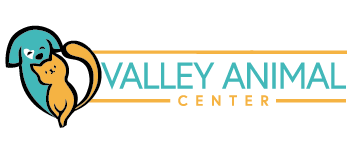Caring for your Pet’s Dental Health
February is Dental Health Month! Are you checking your pet’s teeth?
Your pet’s dental hygiene is important to their overall care, well-being, and long term quality of life. We interviewed Camille Williams, our registered vet tech, here at Valley Animal Center. She shares with us some tips and important information!
Unlike humans, your pet is not able to communicate verbally to you that they have problems with their teeth! Here are some simple signs you can take note of that could mean it’s time to take your pet to the vet for a dental exam.
- Loss of appetite. Oftentimes, when pets have issues with their teeth, they may lose their appetite because eating hurts their mouth. If your pet has not been eating as much as they used to and are losing weight, it could be a warning sign.
- Bad breath. Your pet may not have minty fresh breath, but if you notice that when they come in for a kiss (or when you go in for a kiss) and their breath stinks, it can indicate hygienic issues with your pet’s mouth. Keep a nose out for bad breath!
- Discoloration or loose teeth. If your pet’s teeth show signs of discoloration or if you notice a tooth is looking loose, be sure to consult a vet as soon as you can.
- Redness and swelling of the gums, or anywhere around the face. If you noticed your pet’s teeth are red and/or swollen, it might be time to visit a vet. Similarly, you might think it’s related but if there’s swelling around your pet’s face, that could also be a sign of dental issues. For example, in dogs the carnassial tooth is one of the biggest premolar teeth and it has three roots. One of the roots is actually quite deep and if your dog has an abscess in this root, swelling could happen in the face area, rather than the gums, due to the location of the root.
Just like in humans, when your pet has problems with their mouth it can lead to undesired consequences. Below are just a few of the painful consequences of neglecting your pet’s dental care:
- Loss of teeth. The more you care for your pet’s dental hygiene, the more teeth they have. Otherwise, neglect can lead to a tooth (or many teeth!) being pulled.
- Tooth root abscess. A tooth abscess is basically a pocket of pus caused by bacterial infection. It can happen on various locations of your pet’s teeth and in the worst case scenario, the abscess can burst from your pet’s face.
- Health complications. Because the mouth area is composed of mucous membranes which leads to the blood flow, bacteria in the mouth and gums can get into the bloodstream which can potentially lead to heart murmurs.
After knowing all this, what can you do for your pet’s dental health?
- If your pet allows you to, do try to brush their teeth at least 3 times a week to help with the buildup of plaque. Brushing every day is ideal. (Tip: It’s best to start young so your pet gets used to having their teeth touched and brushed.)
- If your pet doesn’t allow you to brush their teeth, it’s possible for you to slowly train or acclimate teeth brushing into their routine. You can start small by getting your pet used to you touching their mouth, slowly introducing them to flavored pet-toothpaste, using a finger brush instead of a toothbrush, creative positive associations with teeth brushing by rewarding them with treats, etc.
- Dental chews can be a great addition to your pet’s dental care routine. Chewing helps a cat or dog keep their teeth clean so by providing dental chews, you add an easy way for them to keep their mouth and teeth clean and healthy!
- Don’t feed your pet anything that is too hard for them to chew! Did you know, the general rule of thumb many vets advise is: if you can’t dent it with your finger, then it’s too hard for your pet to eat. This includes ice! Yes, we know several dog lovers who feed their canine companions ice because they love it, but ice can potentially fracture your pet’s teeth so it’s better to be safe than sorry!
- A dental exam with a vet is recommended at least once a year, with twice a year being ideal! Tartar buildup accumulates over the years and the rate your pet develops buildup varies, so it’s important to at least get an annual exam and have your pet’s teeth looked at and cleaned!
When it comes to dental health, preventative care is the best care for your pet. Of course, if you’re ever concerned about your pet’s dental health and hygiene, always consult with your veterinarian! Now that you know more about this topic, we hope that your pet continues to have healthy teeth and happy smiles!
Camille Williams is a Registered Vet Technician here at Valley Animal Center. She came to VAC, after having worked in both private and corporate practice, wanting to help homeless animals. She has gotten many joys from being able to directly help with the medical care of shelter animals and with fostering kittens in need.
Valley Animal Center is dedicated to serving animal companions in the Central Valley and beyond. Our mission is to unite dogs and cats with loving people. We believe every animal deserves a loving family and furever home. Through our membership-based dog park and our low-cost clinic, we also provide local and accessible resources and services to the animal lovers and pet communities while rescuing animals in need from local animal control agencies. Donate to support our endless mission.
